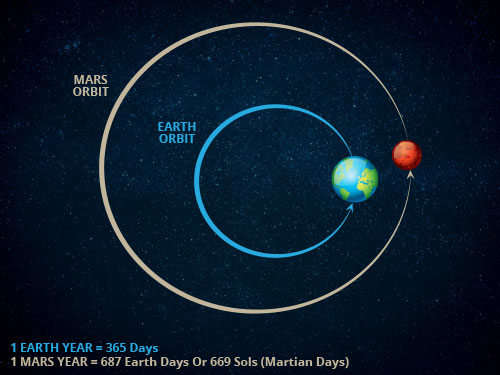SPACECRAFT OPERATIONS
Operating a spacecraft as complex and capable as Curiosity in an efficient and effective way requires the daily hard work of an international team of scientists and engineers across many disciplines. Mars is so far away from Earth that it takes between 4 and 24 minutes for a signal to make the journey. Because of this, it is impossible to plan operations in real time so forget the idea of using a joystick to drive the rover! Instead each Martian day, called a sol, is planned in advance down to the second by the operations team on Earth.
Each sol the rover acquires detailed images as well as scientific data and transmits them back to earth as the downlink capability allows. The mission science team, including APXS scientists, use this data as it arrives on Earth to make planning decisions about what to do on the next sol. Image that outcrop? Measure that rock with APXS? Drive on to the next stop? The long term goals of the mission must be balanced with the desire to measure targets in front of the rover each sol.
PLANNING A SOL: THE GREAT BALANCING ACT
Planning robotic operations on another planet requires juggling many different desires and constraints. Mars is a very inhospitable place, and many resources we take for granted on Earth are in short supply. It is cold; night temperatures often reach below -70C (-95F). As the temperature drops some rover systems, such as the arm and wheel motors, can not be used. Other systems, such as APXS, function best in the deep cold. To get the best science data each sol, shorter APXS measurements are planned in the early morning or late afternoon when it’s warm enough that the arm can move and cold enough that the APXS will produce good data. For longer APXS measurements, the arm deployment can happen in the evening and remain there overnight, leaving APXS in place throughout the cold night when it acquires its best quality data.
Planning is very complex since each instrument has its own equivalent set of constraints which must be factored into its usage along with the other limiting resources like power consumption and battery charge, data volume produced, and the finite hours in the day. All of this is taken into account along with the science goals and long term strategy to craft each sol’s plan.
When making scientific measurements, the team will select the highest value science targets that can be safely analyzed within the limited resources. For APXS, targets must be reachable by the rover arm. To plan these deployments of the arm, the APXS team works closely with the rover planner engineers at JPL to create a plan that achieves the science goals of the measurement and can be safely executed by the rover. Planning rover arm motions is risky business, so great care must be taken not to endanger the spacecraft or instruments.
With targets selected and confirmed to be safe, the APXS team is tasked with delivering command sequences that will integrate with the sequences from all the other subsystems to form the day’s plan. This complete, validated master sequence is uplinked to the rover shortly before it will begin executing.
MAKING A LONG-LONG-DISTANCE CALL
Transmitting data to and from Mars is hard. Like Earth, Mars is spinning on its axis and so it is only possible to communicate directly with the rover once each sol, when the rover is on the side of Mars that is 'visible' from Earth. However, there are several satellites in orbit around Mars and Curiosity uses two of them, named Mars Odyssey and Mars Reconnaissance Orbiter (MRO), to relay data back to Earth. Curiosity transmits as much data as it can to a given orbiter while it is overhead, then when the orbiter is back within sight of Earth it retransmits that same data to be picked up by the enormous radio antennas of NASA’s Deep Space Network.
The planning process is designed to optimize these two communication paths: direct-from-Earth and relay via satellite. The smaller command sequences are transmitted on the morning of each sol close to 10:00 local Mars time, at which time the rover begins executing those new commands. The orbits of each satellite are known in advance, so each sol's command sequence includes pre-planned breaks from collecting new data to transmit when a satellite is overhead. Each sol usually has two or three such "comm passes". As the first data returns to Earth, typically in the afternoon at Gale crater on Mars, the mission operations team gets to work planning the command package that will be ready to uplink on the following Martian morning.
 This is a caption
This is a caption
 This is a caption
This is a caption
 This is a caption
This is a caption
